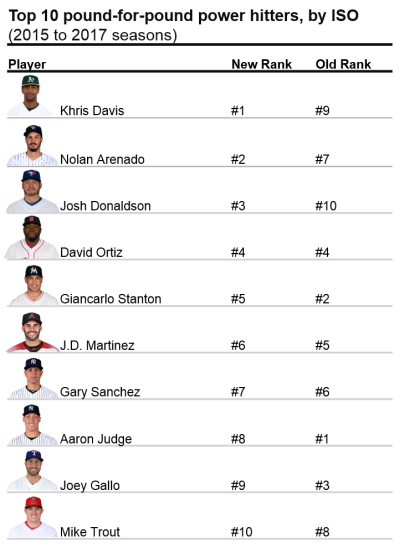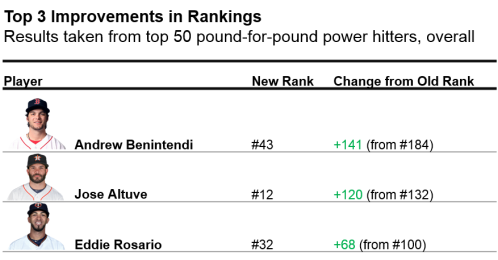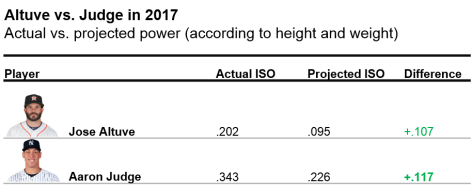Who Are the Top “Pound-for-Pound” Power Hitters?
We all know that Aaron Judge hit for more power this year than Jose Altuve. But, whose power was more impressive? Aaron Judge, who is 6’7 and 282 pounds, has a considerable size advantage over Jose Altuve, at 5’6 and 164 pounds. Perhaps Altuve is actually a better power hitter for his size than is Judge. Let’s expand this idea to the entire league: who is the pound-for-pound top power hitter?
Role of Height and Weight in Batter Power
Using simultaneous linear regression, I estimated the effects of two physical characteristics — height and weight — on batter power. Measures of batter height and weight were taken from MLB.com. For batter power, I used Isolated Power.
As shown in the figures below, weight and height have positive relationships with power.

Weight has a stronger relationship with power than height, though it is difficult to see in the figures alone. (It’s also not intuitively clear exactly how height affects power.) In subsequent analyses, I consider both weight and height.
Who are the top pound-for-pound power hitters?
Using the model, one can predict a batter’s expected power (based on height and weight) and compare it to their actual power.
Who are the top pound-for-pound power hitters? See below for the results.

Khris Davis, formerly the #9 top power hitter, emerges as the #1 pound-for-pound power hitter in baseball. In 2017, Davis, who is three inches and over 30 pounds below average for a Major League hitter, hit a remarkable 43 home runs in 2017, with an ISO of .281. Nolan Arenado and Josh Donaldson made similar jumps in the rankings, from #7 to #2, and #10 to #3, respectively.
Notable power hitters have fallen slightly on this list, though remain in the top 10. For example, Aaron Judge fell from the top spot to #8, while Giancarlo Stanton dropped three spots (#2 to #5). It is important to note here that these power hitters are still impressive – continuing to hold spots in the top 10, regardless of their size.
Biggest improvements in rankings
Which players showed the most improvement in the list? Below are results from the top 50 players on the list.

Andrew Benintendi showed the largest increase in rankings (from 184 to 43). Jose Altuve nearly broke into the top 10, jumping from 132 to 12. Lastly, Eddie Rosario improved 68 spots (100 to 32). Altuve, in particular, has recently shown increases in power (from .146 to .194 to .202 in 2015-2017); as a result, his pound-for-pound status may continually increase in upcoming years.
Who was more impressive?
To reference the initial question in this article: was Jose Altuve’s or Aaron Judge’s power more impressive? Results from the above analyses were compiled from 2015 to 2017 seasons. To compare Altuve and Judge’s recent season, take a look below.

Aaron Judge tops Jose Altuve in the pound-for-pound hitter rankings – by a very thin margin – in 2017. Judge’s power performance exceeded expectations (as predicted by his height and weight) to a slightly higher degree than Altuve.
Full Rankings
If you want to see the full list of hitters for this dataset, including the worst pound-for-pound power hitters (poor Jason Heyward!), click here.
Analysis
I used a general linear model, with the following formula:
ISO = Weight + Weight2 + Height + Height2
Weight and Height were centered prior to analysis.
Estimate Std. Error t value Pr(>|t|)
(Intercept) 0.169874 0.002901 58.563 < 2e-16 ***
Weight 0.019473 0.003009 6.471 3.47e-10 ***
I(Weight^2) -0.003909 0.001573 -2.485 0.01346 *
Height 0.009427 0.002851 3.306 0.00105 **
I(Height^2) 0.001404 0.001590 0.883 0.37793
Steven is a psychologist and data analyst who likes to think about baseball (and other sports) at sportsonmind.wordpress.com
Interesting analysis. From a physics standpoint, taller players should be able to hit for more power, because they can generate more torque (Torque = force x length of bat and arms). Since taller players generally have longer arms, they generate more torque and hit the ball farther. It’s no coincidence that the 2 best power hitters in the game (Judge and Stanton) are also the tallest.
Weight in this case is a proxy for muscle mass and therefore strength. How much of that weight is due to muscle also depends on the height of the player. Therefore, you might be able to improve your model by including the interaction term (Height*Weight).
David, thanks for this. I’m glad there’s some scientific rationale for the role of height in power. I included the Height * Weight term you noted in an early exploratory analysis, but it was not a significant predictor. However, I didn’t include Weight-squared in that analysis, which could be important (based on the non-linear relationship).
He only has 527 career (2016-2017) PA’s in the majors, but, Ryan Schimpf has an ISO of .297 while standing only 5’9” and weighing in at 180 lbs. I just thought he was worth an honorable mention.
YKnotDisco,
Schimpf just missed the PA cutoff (600 PA). If you plug in his height and weight into the formula, I’d venture to guess that he would be #1 on the list. Khris Davis is a bit taller and had an ISO of .27. Thanks for pointing that out.
The new ball might help the smaller players with power because a livelier ball means you need less power to hit bombs and contact ability and launch angle become more important.
Hitting the right launch angle doesn’t require size and former warning track outs might become homers.
Dominikk85, that’s an interesting thought. I’d think that a livelier ball would help smaller and larger hitters equally, unless you think there is some reason that smaller players hit more near-home runs (e.g., warning track outs) than larger players.
Yeah that would be interesting to know. The theory is that if aaron judge hits one well it is gone by a mile and smaller guys hit more first or second row type homers.
But of course quality of contact is not really binary, so it would be interesting to research whether there are buckets of balls.
That makes sense to me, but my (possibly naive) intuition is that while Aaron Judge does hit many balls further than other players, he still has roughly the same amount of balls that land near the warning track as other players. In that case, the juiced ball would help him and others equally.
Fun article. Heyward really is an interesting case. He’s almost as big as Stanton and was once lauded as a power hitter as a prospect. Just amazing how his power all but disappeared.